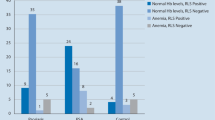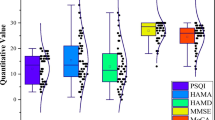Abstract
We aimed to investigate the frequency of restless legs syndrome (RLS) and the associations between RLS and quality of sleep and life in patients with ankylosing spondylitis (AS). One hundred and eight AS patients and 64 controls were included in this study. Demographics, clinical, and laboratory data were recorded. The presence of RLS was determined with face-to-face interview by an experienced neurologist based on the International RLS Study Group criteria. RLS severity was evaluated using International RLS Study Group rating scale. Sleep quality and insomnia severity were assessed by Pittsburgh sleep quality index (PSQI) and insomnia severity index (ISI), respectively. Disease-related quality of life was evaluated by AS quality of life questionnaire (ASQoL). The frequency of RLS was significantly higher in AS patients than in controls (36.4 vs. 14.0 %, p = 0.004). RLS severity score for AS patients was significantly higher than that for controls (p = 0.03). The AS patients had higher scores in the subjective sleep quality, sleep latency, sleep duration, habitual sleep efficiency, sleep disturbances, use of sleep medication domains of PSQI, and also total PSQI and ISI than controls (p < 0.05, for all). ASQoL scores were higher in AS patients with RLS compared to those without RLS (p < 0.001). RLS severity was observed to be independently associated with total PSQI, ISI and ASQoL (p < 0.05, for all). As RLS may adversely affect the sleep and quality of life in AS patients, clinicians should be aware of RLS for early diagnosis and management in AS patients.
Similar content being viewed by others
References
Allen RP, Picchietti D, Hening WA et al (2003) Restless legs syndrome: diagnostic criteria, special considerations, and epidemiology. A report from the restless legs syndrome diagnosis and epidemiology workshop at the National Institutes of Health. Sleep Med 4:101–109
Winkelman JW (2006) Considering the causes of RLS. Eur J Neurol 13(3):8–14
Bayard M, Avonda T, Wadzinski J (2008) Restless legs syndrome. Am Fam Physician 78(2):235–240
Yilmaz NH, Akbostanci MC, Oto A et al (2013) Prevalence of restless legs syndrome in Ankara, Turkey: an analysis of diagnostic criteria and awareness. Acta Neurol Belg 113(3):247–251
Bjorvatn B, Leissner L, Ulfberg J et al (2005) Prevalence, severity and risk factors of restless legs syndrome in the general adult population in two Scandinavian countries. Sleep Med 6:307–312
Allen RP, Stillman P, Myers AJ (2010) Physician-diagnosed restless legs syndrome in a large sample of primary medical care patients in Western Europe: prevalence and characteristics. Sleep Med 11:31–37
Braun J, Sieper J (2007) Ankylosing spondylitis. Lancet 369:1379–1390
Younes M, Jalled A, Aydi Z et al (2010) Socioeconomic impact of ankylosing spondylitis in Tunisia. Jt Bone Spine 77(1):41–46
Abad VC, Sarinas PS, Guilleminault C (2008) Sleep and rheumatologic disorders. Sleep Med Rev 12(3):211–228
Rudwaleit M, Metter A, Listing J et al (2006) Inflammatory back pain in ankylosing spondylitis: a reassessment of the clinical history for application as classification and diagnostic criteria. Arthritis Rheum 54:569–578
Tekatas A, Pamuk ON (2015) Increased frequency of restless leg syndrome in patients with ankylosing spondylitis. Int J Rheum Dis 18(1):58–62
Van der Linden S, Valkenburg HA, Cats A (1984) Evaluation of diagnostic criteria for ankylosing spondylitis. A proposal for modification of the New York criteria. Arthritis Rheum 27(4):361–368
Allen RP, Picchietti DL, Garcia-Borreguero D et al (2014) Restless legs syndrome/Willis–Ekbom disease diagnostic criteria: updated International Restless Legs Syndrome Study Group (IRLSSG) consensus criteria—history, rationale, description, and significance. Sleep Med 15(8):860–873
Walters AS, LeBrocq C, Dhar A et al (2003) Validation of the International Restless Legs Syndrome Study Group rating scale for restless legs syndrome. Sleep Med 4:121–132
Buysse DJ, Reynolds CF 3rd, Monk TH et al (1989) The Pittsburgh sleep quality index: a new instrument for psychiatric practice and research. Psychiatry Res 28(2):193–213
Agargun MY, Kara H, Anlar Ö (1996) Validity and reliability of the Pittsburgh sleep quality index in Turkish sample. Turk J Psychiatry 7:107–115
Bastien CH, Vallieres A, Morin CM (2001) Validation of the insomnia severity index as an outcome measure for insomnia research. Sleep Med 2:297–307
Boysan M, Gülec M, Besiroglu L et al (2010) Psychometric properties of the insomnia severity index in Turkish sample. Anatol J Psychiatry 11:248–252
Doward LC, Spoorenberg A, Cook SA et al (2003) Development of ASQoL: a quality of life instrument specific to ankylosing spondylitis. Ann Rheum Dis 62:20–26
Duruöz MT, Doward L, Turan Y et al. Translation and validation of the Turkish version of the ankylosing spondylitis quality of life (ASQOL) questionnaire. Rheumatol Int 33(11):2717–2722
Akkoc Y, Karatepe AG, Akar S et al (2005) Turkish version of the Bath Ankylosing Spondylitis Disease Activity Index: reliability and validity. Rheumatol Int 25:280–284
Karatepe AG, Akkoc Y, Akar S et al (2005) The Turkish version of the Bath Ankylosing Spondylitis and Dougados Functional indices: reliability and validity. Rheumatol Int 25:612–618
Hening WA, Caivano CK (2008) Restless legs syndrome: a common disorder in patients with rheumatologic conditions. Semin Arthritis Rheum 38:55–62
Taylor-Gjevre RM, Gjevre JA, Skomro R et al (2009) Restless legs syndrome in a rheumatoid arthritis patient cohort. J Clin Rheumatol 15:12–15
Prado GF, Allen RP, Trevisani VM et al (2002) Sleep disruption on systemic sclerosis (scleroderma) patients: clinical and polysomnographic findings. Sleep Med 3:341–345
Stehlik R, Arvidsson L, Ulfberg J (2009) Restless legs syndrome is common among female patients with fibromyalgia. Eur Neurol 61:107–111
Smale S, Tibble J, Sigthorsson G et al (2001) Epidemiology and differential diagnosis of NSAID-induced injury to the mucosa of the small intestine. Best Pract Res Clin Gastroenterol 15:723–728
Hökfelt T, Phillipson O, Goldstein M (1979) Evidence for a dopaminergic pathway in the rat descending from the A11 cell group to the spinal cord. Acta Physiol Scand 107:393–395
Skagerberg G, Björklund A, Lindvall O et al (1982) Origin and termination of the diencephalospinal dopamine system in the rat. Brain Res Bull 9:237–244
Fleetwood-Walker SM, Hope PJ, Mitchell R et al (1988) The influence of opioid receptor subtypes on the processing of nociceptive inputs in the spinal dorsal horn of the cat. Brain Res 451:213–226
Weinstock LB, Walters AS, Paueksakon P (2012) Restless legs syndrome theoretical roles of inflammatory and immune mechanisms. Sleep Med Rev 6:341–354
Salih AM, Gray RE, Mills KR et al (1994) A clinical, serological and neurophysiological study of restless legs syndrome in rheumatoid arthritis. Br J Rheumatol 33:60–63
Hultgren S, Broman JE, Gudbjornsson B et al (2000) Sleep disturbances in outpatients with ankylosing spondylitis: a questionnaire study with gender implications. Scand J Rheumatol 29:365–369
Karadag Ö, Nakas D, Kalyoncu U et al (2012) Effect of anti-TNF treatment on sleep problems in ankylosing spondylitis. Rheumatol Int 32:1909–1913
Deodhar A, Braun J, Inman RD et al (2010) Golimumab reduces sleep disturbance in patients with active ankylosing spondylitis: results from a randomized, placebo-controlled trial. Arthritis Care Res 62:1266–1271
Batmaz İ, Sarıyıldız MA, Dilek B et al (2013) Sleep quality and associated factors in ankylosing spondylitis: relationship with disease parameters, psychological status and quality of life. Rheumatol Int 33(4):1039–1045
Jiang Y, Yang M, Wu H et al (2015) The relationship between disease activity measured by the BASDAI and psychological status, stressful life events, and sleep quality in ankylosing spondylitis. Clin Rheumatol 34(3):503–510
Wolfe F, Michaud K, Li T (2006) Sleep disturbance in patients with rheumatoid arthritis: evaluation by medical outcomes study and visual analog sleep scales. J Rheumatol 33:1942–1951
Lautenbacher S, Kundermann B, Krieg JC (2006) Sleep deprivation and pain perception. Sleep Med Rev 10:357–369
Svetel MV, Jovic JS, Pekmezovic TD, Kostic VS (2015) Quality of life in patients with primary restless leg syndrome: community-based study. Neurol Sci 36(8):1345–1351
Kotsis K, Voulgari PV, Drosos AA et al (2014) Health-related quality of life in patients with ankylosing spondylitis: a comprehensive review. Expert Rev Pharmacoecon Outcomes Res 14(6):857–872
Hening W, Walters AS, Allen RP et al (2004) Impact, diagnosis and treatment of restless legs syndrome (RLS) in a primary care population: the REST (RLS epidemiology, symptoms, and treatment) primary care study. Sleep Med 5:237–246
Author information
Authors and Affiliations
Corresponding author
Ethics declarations
Conflict of interest
The authors declare that they have no conflict of interest.
Ethical approval
All procedures performed in this study were in accordance with the ethical standards of the institutional review board and with the 1964 Helsinki Declaration and its later amendments or comparable ethical standards.
Informed consent
Informed consent was obtained from all individual participants included in the study.
Rights and permissions
About this article
Cite this article
Demirci, S., Demirci, K., Doğru, A. et al. Restless legs syndrome is associated with poor sleep quality and quality of life in patients with ankylosing spondylitis: a questionnaire-based study. Acta Neurol Belg 116, 329–336 (2016). https://doi.org/10.1007/s13760-015-0564-3
Received:
Accepted:
Published:
Issue Date:
DOI: https://doi.org/10.1007/s13760-015-0564-3




